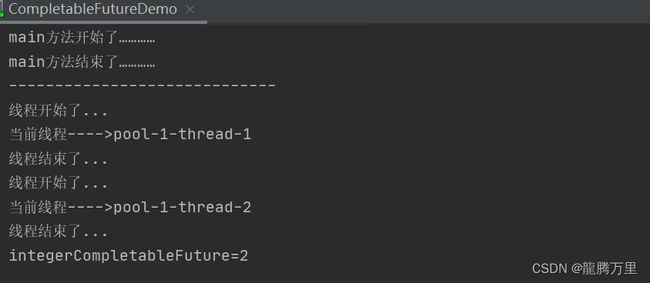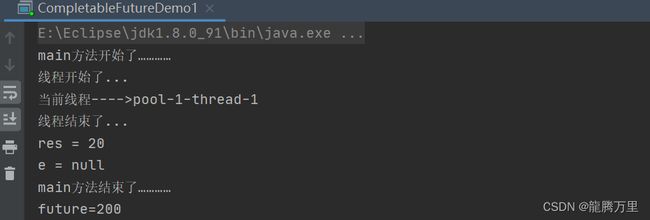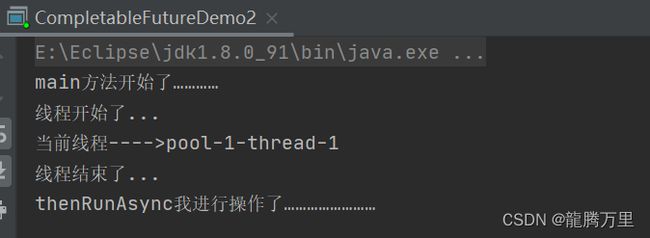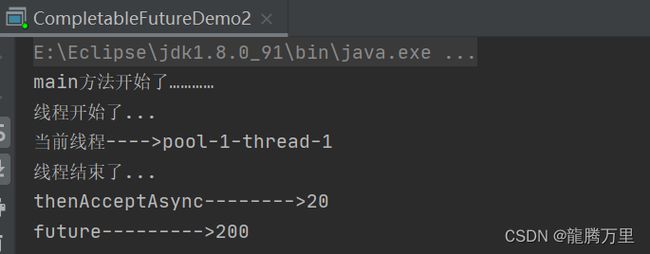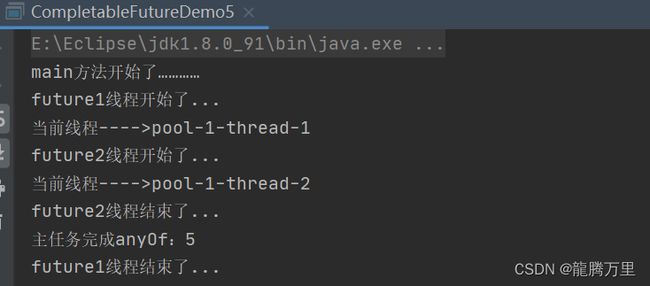【Java8新特性--->异步处理】ComplatableFuture
一、引入
假设一个商品详情页需要以下操作:
- 查询展示商品的基本信息耗时:0.5s
- 查询展示商品的销售信息耗时:0.7s
- 查询展示商品的图片信息耗时:1s
- 查询展示商品销售属性耗时:0.3s
- 查询展示商品规格属性耗时:1.5s
- 查询展示商品详情信息耗时:1s
即使每个查询时间耗时不多,但是加起来却需要很长耗时。为了减少线性执行造成耗时的累积,这就需要引入异步处理做优化。
二、Future介绍
Future是Java 5添加的类,用来描述一个异步计算的结果。
优点:
- 可以使用
isDone方法检查计算是否完成。 - 使用
get阻塞住调用线程,直到计算完成返回结果。 - 可以使用
cancel方法停止任务的执行。
缺点:
- 对于结果的获取却是很不方便,只能通过阻塞或者轮询的方式得到任务的结果。
- 阻塞的方式与我们想及时得到计算结果的期望相违背。
- 轮询的方式会消耗大量CPU资源,并且不能及时得到计算结果。
功能:
- boolean cancel(boolean mayInterruptIfRunning);
1、尝试取消执行此任务。如果任务已经完成、已被取消或由于其他原因无法取消,则此尝试将失败。如果成功,并且调用
cancel时此任务尚未启动,则此任务永远不会运行。
2、 如果任务已经开始,则mayInterruptIfRunning参数确定是否应中断执行此任务的线程以尝试停止任务。 参数mayInterruptIfRunning为true,表示执行此任务的线程应该被中断;否则,允许进行中的任务完成。
3、此方法返回后,后续调用isDone将始终返回true。
4、如果此方法返回true,则对isCancelled的后续调用将始终返回true。
- boolean isCancelled();
如果此任务在正常完成之前被取消,则返回
true,否则返回false。
- boolean isDone();
如果此任务完成,则返回
true。任务完成可能是由于正常终止、异常或取消——在所有这些情况下,此方法将返回true。
- V get() throws InterruptedException, ExecutionException;
阻塞直至任务完成,然后检索其结果。
throws CancellationException:如果计算被取消
throws ExecutionException:如果计算抛出异常
throws InterruptedException:如果当前线程在等待时被中断
- V get(long timeout, TimeUnit unit) throws InterruptedException, ExecutionException, TimeoutException;
如有必要,最多等待计算完成的给定时间,然后检索其结果(如果可用)。
参数timeout:等待的最长时间
参数unit:超时参数的时间单位
throws CancellationException:如果计算被取消
throws ExecutionException:如果计算抛出异常
throws InterruptedException:如果当前线程在等待时被中断
throws TimeoutException:如果等待超时
三、ComplatableFuture
1、介绍
在Java 8中, 新增加了一个包含50个方法左右的类:CompletableFuture,提供了非常强大的Future的扩展功能,可以帮助我们简化异步编程的复杂性,提供了函数式编程的能力,可以通过回调的方式处理计算结果,并且提供了转换和组合CompletableFuture的方法。
CompletableFuture类实现了Future接口,所以你还是可以像以前一样通过 get方法阻塞或者轮询的方式获得结果,但是这种方式不推荐使用。

2、创建异步对象(runAsync、supplyAsync)
CompletableFuture 提供了四个静态方法来创建一个异步操作。
(带有Async默认是异步执行的。这里所谓的异步指的是不在当前线程内执行。)
public static CompletableFuture<Void> runAsync(Runnable runnable)
public static CompletableFuture<Void> runAsync(Runnable runnable, Executor executor)
public static <U> CompletableFuture<U> supplyAsync(Supplier<U> supplier)
public static <U> CompletableFuture<U> supplyAsync(Supplier<U> supplier, Executor executor)
方法分为两类:
- runAsync 没有返回结果
- supplyAsync 有返回结果
测试代码:
public class CompletableFutureDemo {
// corePoolSize:线程池的核心线程数量 线程池创建出来后就会 new Thread() 5个
// maximumPoolSize:最大的线程数量,线程池支持的最大的线程数
// keepAliveTime:存活时间,当线程数大于核心线程,空闲的线程的存活时间 50-5=45
// unit:存活时间的单位
// BlockingQueue workQueue:阻塞队列 当线程数超过了核心线程数据,那么新的请求到来的时候会加入到阻塞的队列中
// new LinkedBlockingQueue<>() 默认队列的长度是 Integer.MAX 那这个就太大了,所以我们需要指定队列的长度
// threadFactory:创建线程的工厂对象
// RejectedExecutionHandler handler:当线程数大于最大线程数的时候会执行的淘汰策略
private static ThreadPoolExecutor executor = new ThreadPoolExecutor(
5,
50,
10,
TimeUnit.SECONDS,
new LinkedBlockingDeque(1000),
Executors.defaultThreadFactory(),
new ThreadPoolExecutor.AbortPolicy()
);
public static void main(String[] args) throws ExecutionException, InterruptedException {
System.out.println("main方法开始了…………");
CompletableFuture<Void> voidCompletableFuture = CompletableFuture.runAsync(() -> {
System.out.println("线程开始了...");
System.out.println("当前线程---->" + Thread.currentThread().getName());
int i = 100 / 50;
System.out.println("线程结束了...");
}, executor);
System.out.println("main方法结束了…………");
System.out.println("-----------------------------");
CompletableFuture<Integer> integerCompletableFuture = CompletableFuture.supplyAsync(() -> {
System.out.println("线程开始了...");
System.out.println("当前线程---->" + Thread.currentThread().getName());
int i = 100 / 50;
System.out.println("线程结束了...");
return i;
}, executor);
System.out.println("integerCompletableFuture=" + integerCompletableFuture.get());
}
}
测试结果:
3、whenCompleteAsync、exceptionally和handleAsync
当CompletableFuture的计算结果完成,或者抛出异常的时候,可以执行特定的Action。主要是下面的方法:
public CompletableFuture<T> whenComplete(BiConsumer<? super T,? super Throwable> action);
public CompletableFuture<T> whenCompleteAsync(BiConsumer<? super T,? super Throwable> action);
public CompletableFuture<T> whenCompleteAsync(BiConsumer<? super T,? super Throwable> action, Executor executor);
public CompletableFuture<T> exceptionally(Function<Throwable,? extends T> fn);
public <U> CompletableFuture<U> handle(BiFunction<? super T, Throwable, ? extends U> fn) ;
public <U> CompletableFuture<U> handleAsync(BiFunction<? super T, Throwable, ? extends U> fn) ;
public <U> CompletableFuture<U> handleAsync(BiFunction<? super T, Throwable, ? extends U> fn, Executor executor) ;
3.1、whenCompleteAsync
可以获取异步任务的返回值和抛出的异常信息,但是不能修改返回结果。
测试代码:
public class CompletableFutureDemo1 {
private static ThreadPoolExecutor executor = new ThreadPoolExecutor(
5,
50,
10,
TimeUnit.SECONDS,
new LinkedBlockingDeque(1000),
Executors.defaultThreadFactory(),
new ThreadPoolExecutor.AbortPolicy()
);
public static void main(String[] args) throws ExecutionException, InterruptedException {
System.out.println("main方法开始了…………");
CompletableFuture<Integer> future = CompletableFuture.supplyAsync(() -> {
System.out.println("线程开始了...");
System.out.println("当前线程---->" + Thread.currentThread().getName());
int i = 100 / 2;
System.out.println("线程结束了...");
return i;
}, executor).whenCompleteAsync((res, e) -> { // 不能修改返回值
System.out.println("res= " + res);
System.out.println("e=" + e);
}, executor);
System.out.println("main方法结束了…………");
System.out.println("future=" + future.get());
}
}
测试结果:
3.2、exceptionally
当异步任务跑出了异常后会触发的方法,如果没有抛出异常该方法不会执行
测试代码:
public class CompletableFutureDemo1 {
private static ThreadPoolExecutor executor = new ThreadPoolExecutor(
5,
50,
10,
TimeUnit.SECONDS,
new LinkedBlockingDeque(1000),
Executors.defaultThreadFactory(),
new ThreadPoolExecutor.AbortPolicy()
);
public static void main(String[] args) throws ExecutionException, InterruptedException {
System.out.println("main方法开始了…………");
CompletableFuture<Integer> future = CompletableFuture.supplyAsync(() -> {
System.out.println("线程开始了...");
System.out.println("当前线程---->" + Thread.currentThread().getName());
int i = 100 / 0;
System.out.println("线程结束了...");
return i;
}, executor).whenCompleteAsync((res, e) -> { // 不能修改返回值
System.out.println("res= " + res);
System.out.println("e=" + e);
}, executor).exceptionally(e -> {
System.out.println("exceptionally执行了,e = " + e);
return 100;
});
System.out.println("main方法结束了…………");
System.out.println("future=" + future.get());
}
}
测试结果: 主动触发算术异常
测试结果: 将int i = 100 / 0;改为int i = 100 / 5;
3.3、handleAsync
可以获取异步任务的返回值和抛出的异常信息,而且可以显示地修改返回的结果
测试代码:
public class CompletableFutureDemo1 {
private static ThreadPoolExecutor executor = new ThreadPoolExecutor(
5,
50,
10,
TimeUnit.SECONDS,
new LinkedBlockingDeque(1000),
Executors.defaultThreadFactory(),
new ThreadPoolExecutor.AbortPolicy()
);
public static void main(String[] args) throws ExecutionException, InterruptedException {
System.out.println("main方法开始了…………");
CompletableFuture<Integer> future = CompletableFuture.supplyAsync(() -> {
System.out.println("线程开始了...");
System.out.println("当前线程---->" + Thread.currentThread().getName());
int i = 100 / 5;
System.out.println("线程结束了...");
return i;
}, executor).handle((res, e) -> {
System.out.println("res = " + res);
System.out.println("e = " + e);
return 200;
});
System.out.println("main方法结束了…………");
System.out.println("future=" + future.get());
}
}
测试效果:
4、线程串行方法
- thenRunAsync 方法:只要之前的执行完成就执行 thenRun的后续操作。(无接受参数,无返回)
- thenAcceptAsync 方法:消费者模式,接受上一个任务处理的结果,并消费处理,无返回结果
- thenApplyAsync 方法:当一个线程依赖另一个线程,获取上一个任务的返回结果,并返回当前任务的结果。
(带有Async默认是异步执行的。这里所谓的异步指的是不在当前线程内执行。)
public CompletionStage<Void> thenRun(Runnable action);
public CompletionStage<Void> thenRunAsync(Runnable action);
public CompletionStage<Void> thenRunAsync(Runnable action,Executor executor);
public CompletionStage<Void> thenAccept(Consumer<? super T> action);
public CompletionStage<Void> thenAcceptAsync(Consumer<? super T> action);
public CompletionStage<Void> thenAcceptAsync(Consumer<? super T> action,Executor executor);
public <U> CompletableFuture<U> thenApply(Function<? super T,? extends U> fn);
public <U> CompletableFuture<U> thenApplyAsync(Function<? super T,? extends U> fn);
public <U> CompletableFuture<U> thenApplyAsync(Function<? super T,? extends U> fn, Executor executor);
4.1、thenRunAsync 实现代码
public class CompletableFutureDemo2 {
private static ThreadPoolExecutor executor = new ThreadPoolExecutor(
5,
50,
10,
TimeUnit.SECONDS,
new LinkedBlockingDeque(1000),
Executors.defaultThreadFactory(),
new ThreadPoolExecutor.AbortPolicy()
);
public static void main(String[] args) throws ExecutionException, InterruptedException {
System.out.println("main方法开始了…………");
CompletableFuture.runAsync(() -> {
System.out.println("线程开始了...");
System.out.println("当前线程---->" + Thread.currentThread().getName());
int i = 100 / 5;
System.out.println("线程结束了...");
}, executor).thenRunAsync(()->{
System.out.println("thenRunAsync我进行操作了……………………");
});
}
}
4.2、thenRunAsync 实现效果
4.3、thenAcceptAsync 实现代码
public class CompletableFutureDemo2 {
private static ThreadPoolExecutor executor = new ThreadPoolExecutor(
5,
50,
10,
TimeUnit.SECONDS,
new LinkedBlockingDeque(1000),
Executors.defaultThreadFactory(),
new ThreadPoolExecutor.AbortPolicy()
);
public static void main(String[] args) throws ExecutionException, InterruptedException {
System.out.println("main方法开始了…………");
CompletableFuture<Void> voidCompletableFuture = CompletableFuture.supplyAsync(() -> {
System.out.println("线程开始了...");
System.out.println("当前线程---->" + Thread.currentThread().getName());
int i = 100 / 5;
System.out.println("线程结束了...");
return i;
}, executor).thenAcceptAsync(res -> {
System.out.println("thenAcceptAsync-------->" + res);
});
}
}
4.4、thenAcceptAsync 实现效果
4.5、thenApplyAsync 实现代码
public class CompletableFutureDemo2 {
private static ThreadPoolExecutor executor = new ThreadPoolExecutor(
5,
50,
10,
TimeUnit.SECONDS,
new LinkedBlockingDeque(1000),
Executors.defaultThreadFactory(),
new ThreadPoolExecutor.AbortPolicy()
);
public static void main(String[] args) throws ExecutionException, InterruptedException {
System.out.println("main方法开始了…………");
CompletableFuture<Integer> future = CompletableFuture.supplyAsync(() -> {
System.out.println("线程开始了...");
System.out.println("当前线程---->" + Thread.currentThread().getName());
int i = 100 / 5;
System.out.println("线程结束了...");
return i;
}, executor).thenApplyAsync(res -> {
System.out.println("thenAcceptAsync-------->" + res);
return 200;
});
System.out.println("future--------->" + future.get());
}
}
4.6、thenApplyAsync 实现效果
5、等待两个任务执行完成后才会触发
- runAfterBothAsync 方法:不可以获取前面两线程的返回结果,本身也没有返回结果。
- thenAcceptBothAsync 方法:可以获取前面两线程的返回结果,本身没有返回结果。
- thenCombineAsync 方法:可以获取前面两线程的返回结果,本身也有返回结果
(带有Async默认是异步执行的。这里所谓的异步指的是不在当前线程内执行。)
5.1、runAfterBothAsync 实现代码
public class CompletableFutureDemo3 {
private static ThreadPoolExecutor executor = new ThreadPoolExecutor(
5,
50,
10,
TimeUnit.SECONDS,
new LinkedBlockingDeque(1000),
Executors.defaultThreadFactory(),
new ThreadPoolExecutor.AbortPolicy()
);
public static void main(String[] args) throws ExecutionException, InterruptedException {
System.out.println("main方法开始了…………");
CompletableFuture<Integer> future1 = CompletableFuture.supplyAsync(() -> {
System.out.println("future1线程开始了...");
System.out.println("当前线程---->" + Thread.currentThread().getName());
int i = 100 / 5;
System.out.println("future1线程结束了...");
return i;
}, executor);
CompletableFuture<Integer> future2 = CompletableFuture.supplyAsync(() -> {
System.out.println("future2线程开始了...");
System.out.println("当前线程---->" + Thread.currentThread().getName());
int i = 100 / 20;
// try {
// Thread.sleep(3000);
// } catch (InterruptedException e) {
// e.printStackTrace();
// }
System.out.println("future2线程结束了...");
return i;
}, executor);
future1.runAfterBothAsync(future2,()->{
System.out.println("任务3执行了");
},executor);
}
}
5.2、runAfterBothAsync 实现效果
如果放开Thread.sleep(3000);,那么 runAfterBothAsync 中的代码会等3s后(也就是等待 future1和 future2都执行完)才执行。
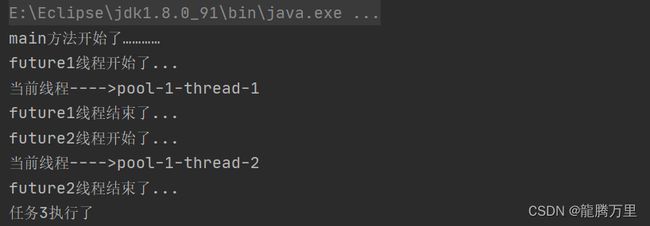
5.3、thenAcceptBothAsync 实现代码
public class CompletableFutureDemo3 {
private static ThreadPoolExecutor executor = new ThreadPoolExecutor(
5,
50,
10,
TimeUnit.SECONDS,
new LinkedBlockingDeque(1000),
Executors.defaultThreadFactory(),
new ThreadPoolExecutor.AbortPolicy()
);
public static void main(String[] args) throws ExecutionException, InterruptedException {
System.out.println("main方法开始了…………");
CompletableFuture<Integer> future1 = CompletableFuture.supplyAsync(() -> {
System.out.println("future1线程开始了...");
System.out.println("当前线程---->" + Thread.currentThread().getName());
int i = 100 / 5;
System.out.println("future1线程结束了...");
return i;
}, executor);
CompletableFuture<Integer> future2 = CompletableFuture.supplyAsync(() -> {
System.out.println("future2线程开始了...");
System.out.println("当前线程---->" + Thread.currentThread().getName());
int i = 100 / 20;
// try {
// Thread.sleep(3000);
// } catch (InterruptedException e) {
// e.printStackTrace();
// }
System.out.println("future2线程结束了...");
return i;
}, executor);
future1.thenAcceptBothAsync(future2, (res1, res2) -> {
System.out.println("thenAcceptBothAsync开始了");
System.out.println("res1 = " + res1);
System.out.println("res2 = " + res2);
System.out.println("thenAcceptBothAsync结束了");
},executor);
}
}
5.4、thenAcceptBothAsync 实现效果
5.5、thenCombineAsync 实现代码
public class CompletableFutureDemo3 {
private static ThreadPoolExecutor executor = new ThreadPoolExecutor(
5,
50,
10,
TimeUnit.SECONDS,
new LinkedBlockingDeque(1000),
Executors.defaultThreadFactory(),
new ThreadPoolExecutor.AbortPolicy()
);
public static void main(String[] args) throws ExecutionException, InterruptedException {
System.out.println("main方法开始了…………");
CompletableFuture<Integer> future1 = CompletableFuture.supplyAsync(() -> {
System.out.println("future1线程开始了...");
System.out.println("当前线程---->" + Thread.currentThread().getName());
int i = 100 / 5;
System.out.println("future1线程结束了...");
return i;
}, executor);
CompletableFuture<Integer> future2 = CompletableFuture.supplyAsync(() -> {
System.out.println("future2线程开始了...");
System.out.println("当前线程---->" + Thread.currentThread().getName());
int i = 100 / 20;
// try {
// Thread.sleep(3000);
// } catch (InterruptedException e) {
// e.printStackTrace();
// }
System.out.println("future2线程结束了...");
return i;
}, executor);
CompletableFuture<Integer> future3 = future1.thenCombineAsync(future2, (res1, res2) -> {
System.out.println("future3开始了");
return res1 + res2;
}, executor);
System.out.println("future3.get()=" + future3.get());
}
}
5.6、thenCombineAsync 实现效果
6、两个任务完成一个就会触发
两个任务只要有一个完成就会触发。
(对于acceptEitherAsync、applyToEitherAsync可接受前面两任务返回结果来说,如果任务有返回值,哪个任务先执行完先获取其结果作为参数)
- runAfterEitherAsync 方法:不可以获取前面两线程的返回结果,本身也没有返回结果。
- acceptEitherAsync 方法:可以获取前面两线程的返回结果,本身也没有返回结果。
- applyToEitherAsync 方法:可以获取前面两线程的返回结果,本身有返回结果。
(带有Async默认是异步执行的。这里所谓的异步指的是不在当前线程内执行。)
6.1、runAfterEitherAsync 实现代码
public class CompletableFutureDemo4 {
private static ThreadPoolExecutor executor = new ThreadPoolExecutor(
5,
50,
10,
TimeUnit.SECONDS,
new LinkedBlockingDeque(1000),
Executors.defaultThreadFactory(),
new ThreadPoolExecutor.AbortPolicy()
);
public static void main(String[] args) throws ExecutionException, InterruptedException {
System.out.println("main方法开始了…………");
CompletableFuture<Integer> future1 = CompletableFuture.supplyAsync(() -> {
System.out.println("future1线程开始了...");
System.out.println("当前线程---->" + Thread.currentThread().getName());
int i = 100 / 5;
// try {
// Thread.sleep(3000);
// } catch (InterruptedException e) {
// e.printStackTrace();
// }
System.out.println("future1线程结束了...");
return i;
}, executor);
CompletableFuture<Integer> future2 = CompletableFuture.supplyAsync(() -> {
System.out.println("future2线程开始了...");
System.out.println("当前线程---->" + Thread.currentThread().getName());
int i = 100 / 20;
// try {
// Thread.sleep(3000);
// } catch (InterruptedException e) {
// e.printStackTrace();
// }
System.out.println("future2线程结束了...");
return i;
}, executor);
future1.runAfterEitherAsync(future2,()->{
System.out.println("runAfterEitherAsync任务执行了");
},executor);
}
}
6.2、runAfterEitherAsync 实现效果
6.3、acceptEitherAsync 实现代码
public class CompletableFutureDemo4 {
private static ThreadPoolExecutor executor = new ThreadPoolExecutor(
5,
50,
10,
TimeUnit.SECONDS,
new LinkedBlockingDeque(1000),
Executors.defaultThreadFactory(),
new ThreadPoolExecutor.AbortPolicy()
);
public static void main(String[] args) throws ExecutionException, InterruptedException {
System.out.println("main方法开始了…………");
CompletableFuture<Integer> future1 = CompletableFuture.supplyAsync(() -> {
System.out.println("future1线程开始了...");
System.out.println("当前线程---->" + Thread.currentThread().getName());
int i = 100 / 5;
try {
Thread.sleep(3000);
} catch (InterruptedException e) {
e.printStackTrace();
}
System.out.println("future1线程结束了...");
return i;
}, executor);
CompletableFuture<Integer> future2 = CompletableFuture.supplyAsync(() -> {
System.out.println("future2线程开始了...");
System.out.println("当前线程---->" + Thread.currentThread().getName());
int i = 100 / 20;
// try {
// Thread.sleep(3000);
// } catch (InterruptedException e) {
// e.printStackTrace();
// }
System.out.println("future2线程结束了...");
return i;
}, executor);
future1.acceptEitherAsync(future2, (res) -> {
System.out.println("acceptEitherAsync开始了");
System.out.println("res = " + res);
},executor);
}
}
6.4、acceptEitherAsync 实现效果
6.5、applyToEitherAsync 实现代码
public class CompletableFutureDemo4 {
private static ThreadPoolExecutor executor = new ThreadPoolExecutor(
5,
50,
10,
TimeUnit.SECONDS,
new LinkedBlockingDeque(1000),
Executors.defaultThreadFactory(),
new ThreadPoolExecutor.AbortPolicy()
);
public static void main(String[] args) throws ExecutionException, InterruptedException {
System.out.println("main方法开始了…………");
CompletableFuture<Integer> future1 = CompletableFuture.supplyAsync(() -> {
System.out.println("future1线程开始了...");
System.out.println("当前线程---->" + Thread.currentThread().getName());
int i = 100 / 5;
try {
Thread.sleep(3000);
} catch (InterruptedException e) {
e.printStackTrace();
}
System.out.println("future1线程结束了...");
return i;
}, executor);
CompletableFuture<Integer> future2 = CompletableFuture.supplyAsync(() -> {
System.out.println("future2线程开始了...");
System.out.println("当前线程---->" + Thread.currentThread().getName());
int i = 100 / 20;
// try {
// Thread.sleep(3000);
// } catch (InterruptedException e) {
// e.printStackTrace();
// }
System.out.println("future2线程结束了...");
return i;
}, executor);
CompletableFuture<Integer> future3 = future1.applyToEitherAsync(future2, (res) -> {
System.out.println("future3开始了");
System.out.println("res = " + res);
return res;
}, executor);
System.out.println("future3.get()=" + future3.get());
}
}
6.6、applyToEitherAsync 实现效果
7、多任务组合
- anyOf 方法:只要有一个任务完成。
- allOf 方法:等待所有任务完成。
public static CompletableFuture<Object> anyOf(CompletableFuture<?>... cfs);
public static CompletableFuture<Void> allOf(CompletableFuture<?>... cfs);
7.1、anyOf 实现代码
只要有一个任务完成就会触发。
public class CompletableFutureDemo5 {
private static ThreadPoolExecutor executor = new ThreadPoolExecutor(
5,
50,
10,
TimeUnit.SECONDS,
new LinkedBlockingDeque(1000),
Executors.defaultThreadFactory(),
new ThreadPoolExecutor.AbortPolicy()
);
/**
* anyOf:只要有一个线程完成,那么就不阻塞
* allOf:所有线程都完成,在 get方法阻塞直至所有线程都完成
*/
public static void main(String[] args) throws ExecutionException, InterruptedException {
System.out.println("main方法开始了…………");
CompletableFuture<Integer> future1 = CompletableFuture.supplyAsync(() -> {
System.out.println("future1线程开始了...");
System.out.println("当前线程---->" + Thread.currentThread().getName());
int i = 100 / 5;
try {
Thread.sleep(3000);
} catch (InterruptedException e) {
e.printStackTrace();
}
System.out.println("future1线程结束了...");
return i;
}, executor);
CompletableFuture<Integer> future2 = CompletableFuture.supplyAsync(() -> {
System.out.println("future2线程开始了...");
System.out.println("当前线程---->" + Thread.currentThread().getName());
int i = 100 / 20;
System.out.println("future2线程结束了...");
return i;
}, executor);
CompletableFuture<Object> anyOf = CompletableFuture.anyOf(future1, future2);
anyOf.get();
System.out.println("主任务完成anyOf:" + anyOf.get());
}
}
7.2、anyOf 实现效果
7.3、allOf 实现代码
阻塞等待所有任务完成才会触发。
public class CompletableFutureDemo5 {
private static ThreadPoolExecutor executor = new ThreadPoolExecutor(
5,
50,
10,
TimeUnit.SECONDS,
new LinkedBlockingDeque(1000),
Executors.defaultThreadFactory(),
new ThreadPoolExecutor.AbortPolicy()
);
/**
* anyOf:只要有一个线程完成,那么就不阻塞
* allOf:所有线程都完成,在 get方法阻塞直至所有线程都完成
*/
public static void main(String[] args) throws ExecutionException, InterruptedException {
System.out.println("main方法开始了…………");
CompletableFuture<Integer> future1 = CompletableFuture.supplyAsync(() -> {
System.out.println("future1线程开始了...");
System.out.println("当前线程---->" + Thread.currentThread().getName());
int i = 100 / 5;
try {
Thread.sleep(3000);
} catch (InterruptedException e) {
e.printStackTrace();
}
System.out.println("future1线程结束了...");
return i;
}, executor);
CompletableFuture<Integer> future2 = CompletableFuture.supplyAsync(() -> {
System.out.println("future2线程开始了...");
System.out.println("当前线程---->" + Thread.currentThread().getName());
int i = 100 / 20;
System.out.println("future2线程结束了...");
return i;
}, executor);
CompletableFuture<Void> allOf = CompletableFuture.allOf(future1, future2);
allOf.get(); // 阻塞在这个位置,等待所有线程的完成
System.out.println("主任务完成allOf:" + future1.get() + "," + future2.get());
}
}
